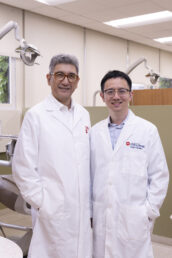Can a chatbot help educate dentistry students?
In the current wave of excitement about artificial intelligence, many advocates have proposed it as a useful tool in education. But skeptics question whether AI-based tools can effectively replicate or supplement human instruction, and whether the information they provide is reliable enough for the classroom.
An innovative study at the UIC College of Dentistry tested these questions by deploying an experimental chatbot in the college’s predoctoral implant clinic. In a new paper published by The Journal of Prosthetic Dentistry, a team led by Dr. Cortino Sukotjo reports positive reviews, with students finding that their AI helper improved classroom experience while decreasing students’ anxiety.
Sukotjo, professor of restorative dentistry and director of the predoctoral implant program, envisioned the chatbot as an interactive tool that could respond to the clinical procedure questions students frequently ask before or during their dental clinic activities. Currently, students can get this information from the online platform Blackboard, but they often just ask faculty for answers. That can create delays and bottlenecks, Sukotjo said.
“If I’m the only one supervising the clinic and I’m already with a student, another student who wants to ask me a question may have to wait several minutes,” Sukotjo said. “Hopefully this chatbot can reduce the burden and the waiting time, so the students can be more efficient in performing their clinical procedures.”
Unlike many other AI tools, this chatbot was not built with large-language models, which recently have dominated headlines about AI advances. Instead, the researchers used a rule-based system, fed with information that was assembled and reviewed by College of Dentistry faculty members.
In the clinic, the chatbot can answer simple questions such as what instruments students will need for a procedure or which code is appropriate for logging information in the electronic patient record. Unlike faculty, it is available 24 hours a day.
“The more questions students ask, the smarter the chatbot becomes,” said Dr. Qiao Fang, clinical assistant professor and the first author of the paper. “Faculty members in the implant clinic also calibrate chatbot answers and strive to avoid providing inaccurate responses to students, thereby maintaining consistent standards in the clinic.”
Researchers split students into two groups: one that used the chatbot and one that used Blackboard. In a survey following the experience, the chatbot group rated their tool as significantly more timely, interactive, anxiety-reducing and recommendable. Their one significant concern was about the potential for incorrect or misleading information, but they recognized that the chatbot reduced faculty workload, allowing more time for deeper instruction and engagement.
Sukotjo was encouraged by the findings to continue improving the chatbot. He’s currently working with software developers to convert it into a smartphone app.
“The favorable reception of the chatbot indicates that young learners may prefer experiences that are more individualized, adaptable and enhanced by technology,” Sukotjo said. “There is a lot of potential here to apply this technology to other clinics in the college. Further, we plan to use this technology to create simulation-based learning in dental education in the future.”
Additional co-authors on the paper include Ibtesam Kamal, Preshika Saini, Fatemeh Solmaz Afshari, Swee Tan and Judy Yuan from the UIC College of Dentistry and Nunung Nurul Qomariyah, Ardelia Shaula Araminta and Raphael Reynaldi at Binus University in Indonesia.


